Vermilacinia, a genus of lichenized fungi in the family Ramalinaceae, is a yellow-green fruticose type of lichen with about 30 species that grow on rocks, trees, and soil within the fog zone along the Pacific Coast of North America and South America. The genus name refers to the thallus being divided into narrow worm-like (vermis) branches (lacinia);the latter part of the name (lacinia) generally applied in descriptions and taxonomic keys such as exemplified in a key to Sonoran Desert species of Ramalina.
Ramalina hyrcana is a species of fruticose lichen in the family Ramalinaceae. Found in the Hyrcanian forest area along the Caspian coast in Iran, it was described as new to science in 2011.
Vermilacinia cedrosensis is a species of pale fruticose lichen that is endemic to Baja California, Mexico.
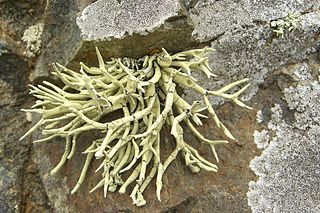
Vermilacinia procera is a fruticose lichen of local occurrences on rocks near the sea along the Pacific Coast from San Francisco California to the Channel Islands, and to Punta Escarpada in Baja California. The species is also reported to occur further south to the Vizcaíno Peninsula and on Cedros Island, but these reports are controversial in view of different interpretations of the species that include V. pumila and V. paleoderma that were not recognized at the time V. procera was described ; for example, a specimen collected on Guadalupe Island by Weber and MCoy (L-3605, COLO that was cited by Phillip Rundel and Peter Bowler in 1994 as belonging to Niebla procera, whereas in a revision of the genus by Richard Spjut in 1996, it was cited as belonging to Vermilacinia paleoderma. Both authorities generally agree to some extent on the description of the species and its geographical range within the California Floristic Province.
Vermilacinia howei is a fruticose lichen that grows on trees and shrubs in the fog regions along the Pacific Coast of North America in the coastal scrub region of the Channel Islands of California, and around Bahía de San Quintín, Baja California and further south in the Vizcaíno Desert. The epithet honors Reginald Heber Howe, Jr. for his contributions to lichenology, especially acknowledged for providing images of the type (biology) specimens in his revision of the genus Ramalina.
Vermilacinia leopardina is a fruticose lichen usually that grows abundantly on the branches of shrubs in the fog regions along the Pacific Coast of North America, in the Channel Islands and on the mainland of California from Santa Barbara County south to the Vizcaíno Peninsula of Baja California. The species is also reported to occur in Chile, based on a single specimen mounted on a large index card off to one corner with the type (biology) of Usnea tumidula in the center and bottom ; it is possible that the specimen of V. leopardina was from North America and placed on the card for the purpose of making a comparison to the type for Usnea tumidula, which was annotated Ramalina ceruchis var. gracilior Muell.Arg., a name of uncertain status. The epithet, leopardina, is in reference to the black transverse bands and irregularly shaped black spots commonly seen on the thallus branches that obviously imply a similarity to the leopard animal, while also making comparative distinctions to other black banded species: V. tigrina and V. zebrina, obviously to a tiger and zebra, and to V. leonis, obviously a lion, which has no black stripes.
Vermilacinia tigrina is a fruticose lichen that grows on branches of shrubs and on earth among cactus and shrubs in the fog regions along the Pacific Coast of North America and South America; in North America found in the Channel Islands and near San Diego, California, and in central and southern Baja California; and in South America from Peru to Chile. The epithet is in reference to the irregular black spots or bands on the thallus branches.
Niebla podetiaforma is a fruticose lichen that grows frequently on small stones in fog regions along the Pacific Coast of Baja California from San Vicente Canyon to Morro Santo Domingo. The epithet, podetiaforma is in reference to a primary inflated branch of the thallus that resembles a podetium, a common feature in the lichen genus Cladonia.
Punctelia constantimontium is a species of foliose lichen in the family Parmeliaceae. Its range includes South America, Africa, and Mexico, where it grows on bark and twigs.

Punctelia hypoleucites, commonly known as the southwestern speckled shield lichen, is a species of foliose (leafy) lichen in the family Parmeliaceae. First formally described by Finnish botanist William Nylander as a species of Parmelia, it was transferred to the genus Punctelia in 1982. The lichen is found in Africa, North America, and South America, where it grows on the bark of both hardwood and coniferous trees. Its greenish-grey thallus is covered with tiny white pseudocyphellae – minute holes in the thallus surface that facilitate gas exchange. Some macroscopic features that help distinguish this species from other related members of the genus include the presence and the structure of the apothecia, the absence of asexual surface propagules, and the light brown color of the thallus undersurface. Chemically, the presence of lecanoric acid in the medulla and atranorin in the cortex help distinguish it from lookalikes.

Punctelia perreticulata is a widely distributed species of foliose lichen in the family Parmeliaceae. It occurs in Mediterranean Europe and Russia, North America, South America, Australia, and New Zealand, where it grows on rocks, bark, or wood. Its main distinguishing features are its thallus surface, marked with many shallow depressions, grooves, or pits, and sorediate pseudocyphellae. The lower side of the thallus is ivory to tan towards the centre and the major secondary metabolite in the medulla is lecanoric acid. A lookalike species with which it has been historically confused is Punctelia subrudecta; this lichen can be distinguished from Punctelia perreticulata by the texture of the thallus surface, or, more reliably, by the length of its conidia.

Punctelia graminicola is a species of foliose (leafy) lichen in the family Parmeliaceae. It grows on rocks, and, less frequently, on bark in North America, South America, and East Africa. It has a blue-grey thallus measuring up to about 15 cm (6 in), covered with tiny pores called pseudocyphellae. Sometimes the lichen forms small lobes that project out from the surface. Fruiting bodies are uncommon in this species; if present, they resemble small cups with a brown internal disc measuring 3–10 mm (0.1–0.4 in) in diameter. A lookalike species, Punctelia hypoleucites, is not readily distinguishable from Punctelia graminicola by appearance or habitat alone; these species can only be reliably differentiated by examining the length of their conidia.
Ramalina geniculatella is a species of saxicolous (rock-dwelling), fruticose lichen in the family Ramalinaceae. It is found in the remote tropical island of Saint Helena, where it grows on boulders and cliffs. It was formally described as a new species in 2008 by Dutch lichenologist André Aptroot. The type specimen was collected by the author from Prosperous Bay Plain at an elevation of 330 m (1,080 ft); there, it was found growing on basalt. The initially shrub-like, fruticose thallus of the lichen later becomes pendant, reaching lengths of up to 20 cm (8 in), although typically it is smaller, about 7 cm (2.8 in). The branches of the thallus are about 0.5–1.2 mm wide and about 0.2–0.5 mm thick; they are geniculate below the apothecia. The species epithet refers to this characteristic feature. Although the branches are greenish-grey, they are covered with whitish pseudocyphellae, which gives the thallus an overall whitish appearance. Thin-layer chromatography shows that the species contains usnic acid, and sometimes boninic acid and protocetraric acids. The photobiont partner is dispersed in irregular groups throughout the medulla.
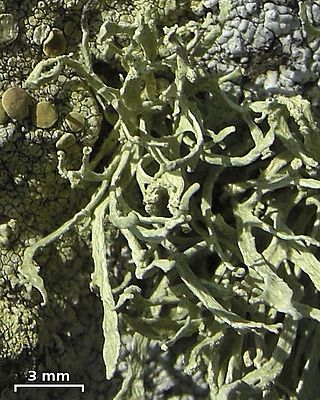
Ramalina polyforma is a species of saxicolous (rock-dwelling), fruticose lichen in the family Ramalinaceae. This greenish-grey shrubby lichen, endemic to the Galápagos Islands, was formally described as a new species in 2007 by Dutch lichenologist André Aptroot.
Hypogymnia amplexa is a species of corticolous (bark-dwelling), foliose lichen in the family Parmeliaceae. It is found in the western United States and Canada.
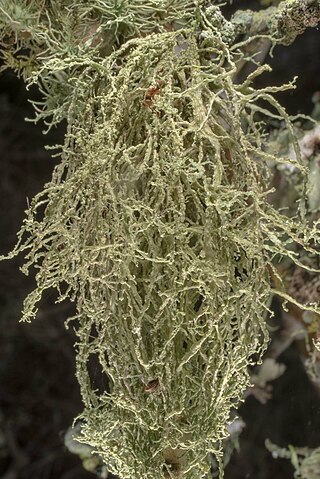
Ramalina peruviana is a species of fruticose lichen in the family Ramalinaceae with a pantropical distribution. The lichen was first formally described by Erik Acharius in 1810, who wrote of its flat, compressed, branching thallus with narrow, undulating branches. It typically occurs on the bark of trees (corticolous) although occasionally it grows on rocks (saxicolous). Ramalina peruviana is widely distributed, found in subtropical and warm temperate regions across several continents. It has been recorded in diverse locations such as Pacific Islands, the southern United States, East Africa, Asia, Australasia, and South America. Its presence has been documented in specific habitats like mangroves in Australia and on certain tree species in Taiwan and China, where it thrives at higher elevations.
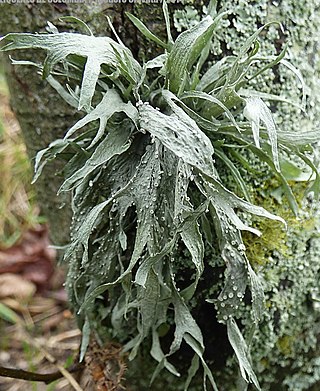
Ramalina celastri is a species of corticolous and lignicolous, fruticose lichen in the family Ramalinaceae. It is a widespread species with a pantropical distribution.
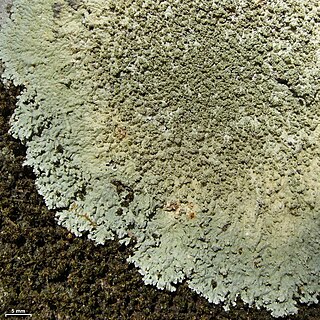
Dirinaria aegialita is a species of foliose lichen in the family Caliciaceae. It is found in tropical regions around the world, with scattered occurrences in subtropical North America.
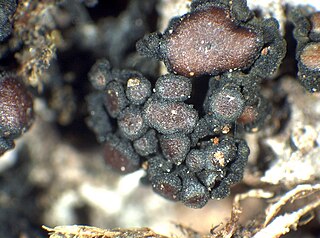
Enchylium conglomeratum, commonly known as dotted jelly lichen, is a species of foliose lichen in the family Collemataceae. Formerly known as Collema conglomeratum, it was renamed in 2013. This lichen has a fragmented distribution across the Holarctic region, occurring in both North America and Europe.

Enchylium polycarpon, commonly known as the shaly jelly lichen, is a species of foliose lichen in the family Collemataceae. Formerly known as Collema polycarpon, it was renamed in 2013 as part of a taxonomic revision. This lichen has a widespread global distribution, occurring in various regions of North America, Europe, Africa, and Asia.











